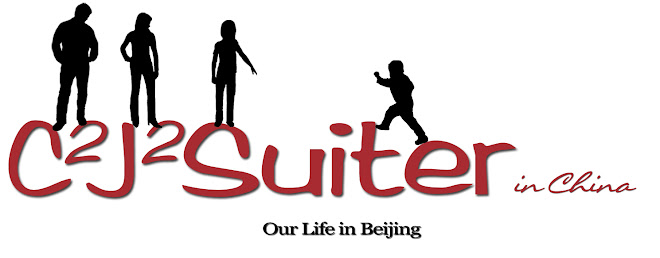...Attacked Jeffrey
Jeffrey is fond of the massages here (actually having one as I’m typing this!) but a couple of days ago he decided to go onto the next step of the TCM* or Traditional Chinese Medicine (中医 - Zhong1Yi1).
Looking like he was coming down with a cold, the secretaries at his office told him he should go and have a massage (like he needed to be pushed!)…as he entered the massage parlor coughing the “masseuse” took upon herself to fix him!
 |
| This is the result of cupping (NOT an octopus attack!). |
Cupping (拔罐) is a method of treating disease that is caused by local congestion but placing several glass "cups" (open spheres) on the body. A match is lit and placed inside the cup and then removed before placing the cup against the skin. The resulting effect is the burning of oxygen within the cup, creating a relative vacuum that allows the cup to stick to the skin via suction.
The underlying tissue is drawn up into the jar forming an area of blood stasis. This appears to bruise the area, or at least turn it a bright red. The amount of dark red or even purple blood drawn to the surface indicates the degree of stagnation. Dark blood is a sign of stagnation, which in many cases in modern terms is the amount of toxins in the blood. These bruises are not dangerous and disappear in a few days.
Cupping is generally indicated in the treatment of Arthritic pain, abdominal pain, stomach ache, indigestion, headache, hypertension, common cold, cough, low back pain, painful menstruation, insect and poisonous snake bite.
* FYI: Traditional Chinese Medicine is largely based on the philosophical concept that the human body is a small universe with a set of complete and sophisticated interconnected systems, and that those systems usually work in balance to maintain the healthy function of the human body. The balance of yin and yang is considered with respect to qi ("breath", "life force", or "spiritual energy"), blood, jing ("kidney essence", including "semen"), other bodily fluids, the five elements, emotions and the soul or spirit (shen). TCM has a unique model of the body, notably concerned with the meridian system. Unlike the Western anatomical model which divides the physical body into parts, the Chinese model is more concerned with function. Thus, the TCM spleen is not a specific piece of flesh, but an aspect of function related to transformation and transportation within the body, and of the mental functions of thinking and studying. (source: Wikipedia)






















